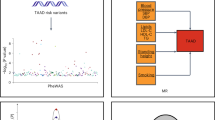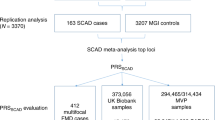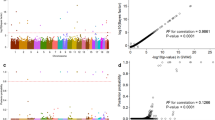Abstract
Although thoracic aortic aneurysms and dissections (TAAD) can be inherited as a single-gene disorder, the genetic predisposition in the majority of affected people is poorly understood. In a multistage genome-wide association study (GWAS), we compared 765 individuals who had sporadic TAAD (STAAD) with 874 controls and identified common SNPs at a 15q21.1 locus that were associated with STAAD, with odds ratios of 1.6–1.8 that achieved genome-wide significance. We followed up 107 SNPs associated with STAAD with P < 1 × 10−5 in the region, in two separate STAAD cohorts. The associated SNPs fall into a large region of linkage disequilibrium encompassing FBN1, which encodes fibrillin-1. FBN1 mutations cause Marfan syndrome, whose major cardiovascular complication is TAAD. This study shows that common genetic variants at 15q21.1 that probably act via FBN1 are associated with STAAD, suggesting a common pathogenesis of aortic disease in Marfan syndrome and STAAD.
This is a preview of subscription content, access via your institution
Access options
Subscribe to this journal
Receive 12 print issues and online access
$209.00 per year
only $17.42 per issue
Buy this article
- Purchase on Springer Link
- Instant access to full article PDF
Prices may be subject to local taxes which are calculated during checkout


Similar content being viewed by others
References
Milewicz, D.M., Dietz, H.C. & Miller, D.C. Treatment of aortic disease in patients with Marfan syndrome. Circulation 111, e150–e157 (2005).
Guo, D.C. et al. Mutations in smooth muscle α-actin (ACTA2) lead to thoracic aortic aneurysms and dissections. Nat. Genet. 39, 1488–1493 (2007).
Milewicz, D.M. et al. Genetic basis of thoracic aortic aneurysms and dissections: focus on smooth muscle cell contractile dysfunction. Annu. Rev. Genomics Hum. Genet. 9, 283–302 (2008).
Wang, L. et al. Mutations in myosin light chain kinase cause familial aortic dissections. Am. J. Hum. Genet. 87, 701–707 (2010).
Zhu, L. et al. Mutations in myosin heavy chain 11 cause a syndrome associating thoracic aortic aneurysm/aortic dissection and patent ductus arteriosus. Nat. Genet. 38, 343–349 (2006).
Braverman, A.C. et al. The bicuspid aortic valve. Curr. Probl. Cardiol. 30, 470–522 (2005).
Svensson, L.G. Aortic valve stenosis and regurgitation: an overview of management. J. Cardiovasc. Surg. (Torino) 49, 297–303 (2008).
Svensson, L.G., Blackstone, E.H. & Cosgrove, D.M. III. Surgical options in young adults with aortic valve disease. Curr. Probl. Cardiol. 28, 417–480 (2003).
Larson, E.W. & Edwards, W.D. Risk factors for aortic dissection: a necropsy study of 161 cases. Am. J. Cardiol. 53, 849–855 (1984).
Hiratzka, L.F. et al. 2010 ACCF/AHA/AATS/ACR/ASA/SCA/SCAI/SIR/STS/SVM guidelines for the diagnosis and management of patients with Thoracic Aortic Disease: a report of the American College of Cardiology Foundation/American Heart Association Task Force on Practice Guidelines, American Association for Thoracic Surgery, American College of Radiology, American Stroke Association, Society of Cardiovascular Anesthesiologists, Society for Cardiovascular Angiography and Interventions, Society of Interventional Radiology, Society of Thoracic Surgeons, and Society for Vascular Medicine. Circulation 121, e266–e369 (2010).
Brautbar, A. et al. FBN1 mutations in patients with descending thoracic aortic dissections. Am. J. Med. Genet. A. 152A, 413–416 (2010).
Milewicz, D.M. et al. Fibrillin-1 (FBN1) mutations in patients with thoracic aortic aneurysms. Circulation 94, 2708–2711 (1996).
Prakash, S.K. et al. Rare copy number variants disrupt genes regulating vascular smooth muscle cell adhesion and contractility in sporadic thoracic aortic aneurysms and dissections. Am. J. Hum. Genet. 87, 743–756 (2010).
Kuang, S.Q. et al. Recurrent chromosome 16p13.1 duplications are a risk factor for aortic dissections. PLoS Genet. 7, e1002118 (2011).
Milewicz, D.M., Carlson, A.A. & Regalado, E.S. Genetic testing in aortic aneurysm disease: PRO. Cardiol. Clin. 28, 191–197 (2010).
Habashi, J.P. et al. Losartan, an AT1 antagonist, prevents aortic aneurysm in a mouse model of Marfan syndrome. Science 312, 117–121 (2006).
Holm, T.M. et al. Noncanonical TGFβ signaling contributes to aortic aneurysm progression in Marfan syndrome mice. Science 332, 358–361 (2011).
Xiong, W., Knispel, R.A., Dietz, H.C., Ramirez, F. & Baxter, B.T. Doxycycline delays aneurysm rupture in a mouse model of Marfan syndrome. J. Vasc. Surg. 47, 166–172 (2008).
Eagle, K.A. Rationale and design of the National Registry of Genetically Triggered Thoracic Aortic Aneurysms and Cardiovascular Conditions (GenTAC). Am. Heart J. 157, 319–326 (2009).
Mahan, S., Ardlie, K.G., Krenitsky, K.F., Walsh, G. & Clough, G. Collaborative design for automated DNA storage that allows for rapid, accurate, large-scale studies. Assay Drug Dev. Technol. 2, 683–689 (2004).
Roman, M.J., Devereux, R.B., Kramer-Fox, R. & O'Loughlin, J. Two-dimensional echocardiographic aortic root dimensions in normal children and adults. Am. J. Cardiol. 64, 507–512 (1989).
The Wellcome Trust Case Control Consortium. Genome-wide association study of 14,000 cases of seven common diseases and 3,000 shared controls. Nature 447, 661–678 (2007).
Purcell, S. et al. PLINK: a tool set for whole-genome association and population-based linkage analyses. Am. J. Hum. Genet. 81, 559–575 (2007).
Li, Y. & Abecasis, G. Mach 1.0: rapid haplotype reconstruction and missing genotype inference. Am. J. Hum. Genet. S79, 2290 (2006).
Li, Y., Willer, C., Sanna, S. & Abecasis, G. Genotype imputation. Annu. Rev. Genomics Hum. Genet. 10, 387–406 (2009).
International HapMap Consortium. A haplotype map of the human genome. Nature 437, 1299–1320 (2005).
Li, Y., Willer, C.J., Ding, J., Scheet, P. & Abecasis, G.R. MaCH: using sequence and genotype data to estimate haplotypes and unobserved genotypes. Genet. Epidemiol. 34, 816–834 (2010).
Acknowledgements
This work was supported by grants from the US National Institutes of Health (P50-HL083794 and R01-HL62594 to D.M.M.; UL1RR024148 and UL1RR025758 (CTSA); K08-HL080085 to S.A.L.), as well as the Doris Duke Charitable Trust, the Vivian L. Smith Foundation, the TexGen Foundation and the Thoracic Surgery Foundation for Research and Education.
GenTAC participating centers and their investigators are as follows: Johns Hopkins University School of Medicine, K.W.H., H.C. Dietz, W. Ravekes, K. Lurman; University of Texas Health Science Center at Houston, D.M.M., A. Carlson; Baylor College of Medicine, S.A.L., J.L. Jefferies, I.V. Volguina; Oregon Health & Science University, C.M., H.K. Song, V. Menashe, M. Silberbach, J.D. Kushner; Perelman School of Medicine at the University of Pennsylvania, R.E.P., J.E.B., M. Morales; Weill Cornell Medical College, C.T. Basson, R.D., J.W. Weinsaft, D. McDermott; University of Michigan Medical School, K.E.; US National Heart, Lung, and Blood Institute, H.E. Tolunay, P. Desvigne-Nickens, M.P. Stylianou, M. Mitchell; RTI International, B.L. Kroner, D. Brambilla, T. Hendershot, D. Ringer, M. Cunningham, M. Kindem. The GenTAC registry is supported by US Federal Government Contract N01-HV-68199 from the National Heart, Lung, and Blood Institute and by the National Institute of Arthritis and Musculoskeletal and Skin Diseases.
We thank the GenTAC investigators, collaborators and coordinators; NINDS and WTCCC for giving us the use of their control data; S.N. Palmer, N. Stancel and R. Bartow for editorial assistance; Y. Khalil for subject recruitment; Z. Ren for technical support; A. Kicza for her dedicated work contacting and talking to subjects; and all of the subjects who participated in this research. We thank the surgeons of Brigham and Women's Hospital: S.F. Aranki, R.M. Bolman III, F.Y. Chen, L.H. Cohn, G.S. Couper, M. Davidson, R.J. Rizzo and P. Shekar. We also thank the surgeons of Massachusetts General Hospital: A. Agnihotri, C. Akins, A.D. Hilgenberg, T.E. MacGillivray, J.C. Madsen, B.R. Rosengard, D.F. Torchiana, G.J. Vlahakes and J.D. Walker.
Author information
Authors and Affiliations
Contributions
S.A.L., J.W.B. and D.M.M. were the principal investigators who conducted the study. S.A.L. and D.M.M. coordinated and oversaw the study. L.R., R.J.J., C.C.M., D.M.M., S.A.L., J.S.C., H.J.S. and A.L.E. participated in study enrollment for stages 1 and 2, helped gather related detailed clinical information and biological samples, and helped carry out the clinical analysis. R.E.P., J.E.B., R.D., C.M., K.W.H., K.E., S.C.B., C.S., J.G.S. and E.M.I. participated in study enrollment for stages 2 and 3 and helped gather related detailed clinical information and biological samples. D.G. and M.N. participated in the preparation of biological samples. M.B., J.W.B., M.R.B. and L.M.F. carried out the genotyping. M.-L.N.M. and S.M.L. were responsible for bioinformatics and all statistical analyses. S.A.L., M.-L.N.M., D.G., S.M.L. and D.M.M. wrote the manuscript.
Corresponding author
Ethics declarations
Competing interests
The authors declare no competing financial interests.
Supplementary information
Supplementary Text and Figures
Supplementary Figures 1 and 2; Supplementary Tables 1-11 (PDF 2731 kb)
Rights and permissions
About this article
Cite this article
LeMaire, S., McDonald, ML., Guo, Dc. et al. Genome-wide association study identifies a susceptibility locus for thoracic aortic aneurysms and aortic dissections spanning FBN1 at 15q21.1. Nat Genet 43, 996–1000 (2011). https://doi.org/10.1038/ng.934
Received:
Accepted:
Published:
Issue Date:
DOI: https://doi.org/10.1038/ng.934
This article is cited by
-
Multi-omics in thoracic aortic aneurysm: the complex road to the simplification
Cell & Bioscience (2023)
-
Genetics and mechanisms of thoracic aortic disease
Nature Reviews Cardiology (2023)
-
Contribution of environmental, genetic and epigenetic factors to obesity-related metabolic syndrome
The Nucleus (2023)
-
Integrating oculomics with genomics reveals imaging biomarkers for preventive and personalized prediction of arterial aneurysms
EPMA Journal (2023)
-
Genome-wide association study of thoracic aortic aneurysm and dissection in the Million Veteran Program
Nature Genetics (2023)



